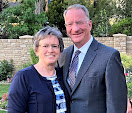Elder Darrel L. Hammon
We had the opportunity to visit La Isabela, the place where Christopher Columbus and
1500 of his fellow Spaniards established the first European town in the Americas in
1494. It is located on the north coast, just west and north of Puerto Plata.
Once we arrived, one of the guides there took us on a tour of the ruins.
Unfortunately, one of the Dominican Republic’s former dictators destroyed the original site, leaving just rock footings where archeologists feel the
actual foundations were located.
As we walked around each of the rock
formations, our guide told us what they believe were the buildings—the church,
the treasury, the storage place, the homes, and other sites. I was impressed with the site although I was saddened when I saw what little remained. What a historical loss!
We also understand, though, the government is planning to restore La Isabela to its original form. According to our guide, only about 10,000 visitors come to La Isabela. Part of the challenge is getting there. There is no signage except at the entrance of the park, which you see above. Fortunately and thanks to Google Earth, we had the GPS coordinates. With an added focus on tourism, the new government will hopefully restore La Isabela to its original beauty and significance.
The following pictures are just representative of the different foundations we saw.
This is what they call "la Casa del Almirante"--Or the House of the Admiral
La Isabela site has a very nice museum.
The picture below represents the storehouse where they placed their goods and things from their voyages to keep safe and to disburse when needed. From the size of the spot, it appears to have been a fairly large building.
This view is looking out into the bay.
Another view of the storage building site
This picture represents the old church. A replica of this church was built just down the path to the right, through the woods, and across the road. People actually worship in the one across the street.
This is one of the cadavers the archeologists unearthed. They kept this one on top of the ground to show people how the Spaniards buried their dead, especially those who believed in Christ. At this spot lies one of the Spaniards above ground, arms folded in typical Christian burial style. It was almost surreal looking at him. Other graves, marked by simple crosses, lay scattered in two or three spots where they believe more are buried.
I loved this mural, which was located on the side of the museum. There are several more, but because of the space on this blog, I was not able to post all of them. If you go to my Facebook page, you will be able to see more of the murals.
This is our La Isabela guide. He sincerely believes the government will be restoring this site to its original look, based on historical records. That will be a wonderful day when that happens. La Isabela is an important historical site for all of the world. According to our guide, many dignities will be here in October to celebrate its importance.






























